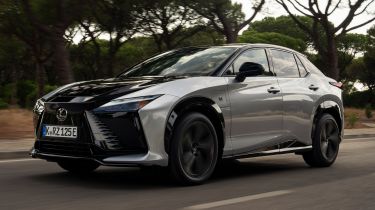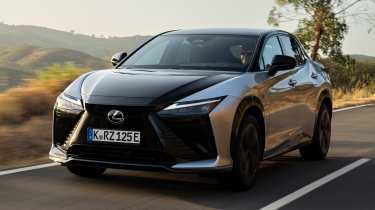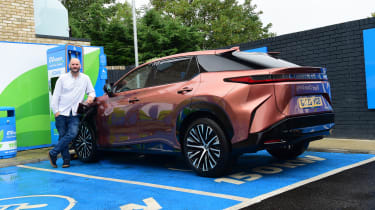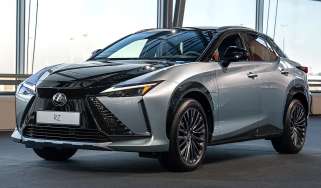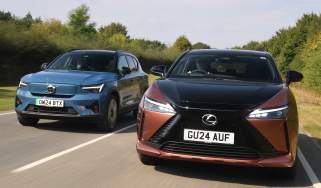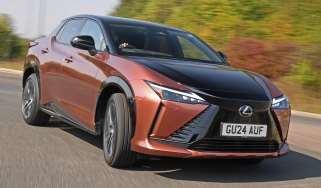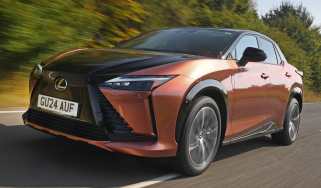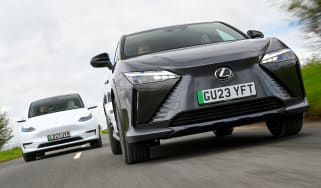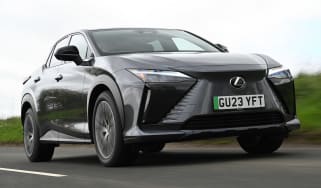Lexus RZ review
The updated Lexus RZ is a compelling alternative to the mainstream electric SUV elite

Our opinion on the Lexus RZ
Given the facelifted Lexus RZ retains the same sharp lines and pointy details of its predecessor, you’d be forgiven for thinking that little has changes. However, lots of changes have been brought in underneath as Lexus moves to address initial concerns, namely by increasing its power, extending its range and cutting its charging times. Along with various suspension and structural upgrades, this EV has improved as a package.
However, choose the fancy new steer-by-wire system carefully, because its bizarre steering ‘yoke’ is not for everyone. The 500e is a better all-rounder than the flagship 550e F Sport, too.
| Key specs | |
| Fuel type | Electric |
| Body style | Five-door coupe-SUV |
| Powertrain | 77kWh battery, 1x e-motor, front-wheel drive 77kWh battery, 2x e-motors, four-wheel drive |
| Safety | 5-star Euro NCAP (2023) |
| Warranty | 3 years/60,000 miles (up to 10 years/100,000 miles with routine franchised dealer servicing) |
About the Lexus RZ
Fresh off the back of its most successful year ever in the UK, Lexus has given the electric RZ coupe-SUV a light technical overhaul. It’s only the second full-EV from the firm, but the RZ has proved popular since its 2023 launch, with 3,300 examples finding homes here.
But while early impressions of the RZ were largely positive, there were some problems, such as its relatively short range and its comparatively slow charging times. So this round of remedial work focuses mostly on stuff you can’t see – this isn’t a facelift in the conventional sense; the swoopy coupe-SUV form sneaks through largely untouched.
Used - available now
The principal talking points here, therefore, are that the battery capacity has increased to 77kWh (previously 71.4kWh), while changes to its cell make-up and the adoption of a peak higher AC charging speed of 22kW has reduced the amount of time owners should have to wait with the vehicle plugged in.
Despite looking like a coupe SUV, the amount of space inside is good, thanks to a low-set floor. There are two or four-wheel drive versions on offer, with the front-wheel drive version badged RZ 350e, while four-wheel drive is reserved for the 500e and 550e.
Trim levels have altered as part of the facelift, with the least expensive Urban model being dropped. Premium trim takes its place as the entry-level model, and is available in 350e and 500e guises. As well as a full suite of safety systems as standard, there’s also an electric tailgate, a fixed panoramic glass roof, privacy glass, electrically adjustable and heated front seat adjustment, and a heated steering wheel.
Premium Plus trim builds on this with a head-up display, a 360-degree camera system, driver’s seat memory settings, front seat ventilation, and electric steering wheel adjustment.
Takumi trim comes exclusively in 500e form, along with an 1,800-watt, 13-speaker Mark Levinson sound system, adaptive headlights, and interior ambient lighting.
For the first time, the RZ can be ordered in sportier looking F Sport trim with plenty of exterior and interior details that set it apart from its more conservative siblings. But it’s more than just an appearance package because this trim level gets the most potent 550e four-wheel drive set-up along with steer-by-wire and interactive manual drive for a more engaging driving experience. Finally, F Sport Takumi comes with all the goodies of the Takumi trim, just with the sportier exterior of F Sport.
Performance & driving experience
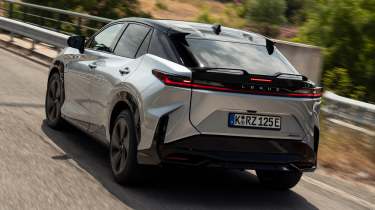
| Pros |
|
| Cons |
|
While the Lexus RZ looks sharp, the driving experience is geared towards comfort rather than sportiness, and that’s to the car’s benefit.
Performance, 0-60mph acceleration and top speed
The power output of all RZ models has swelled, resulting in the old 300e and 450e being replaced by the 350e and 500e, respectively. There’s also a new range-topping 550e, which is the first RZ offered in racier F Sport and F Sport Takumi trims. Outputs for the newcomers range between 221bhp (350e), 376bhp (500e), and 402bhp (550e). The latter is a serious gain over the old 450e, which topped out at 309bhp.
The 350e has just about enough punch, as its 7.5 second 0-62mph time will attest. With 269Nm of torque, to feel able to keep up with regular traffic flow without difficulty. However, the muscular 500e is the more fitting on-road performer for a premium brand like Lexus, and it’s 4.6 second 0-62mph time is now a match for the Long Range AWD Tesla Model Y.
Rather than its 4.4 second 0-62mph time, it’s the Interactive Manual Drive fitted to the 550e which makes this version stand out. It uses torque interruption from the motors and synthetic noises to simulate driving a combustion car with gears. Unfortunately, those ‘gears’ are ripped through way too quickly and the RZ makes a truly peculiar digital noise – a bit like an industrial cement mixer overlaid with a jet engine – as it accelerates. It’s a noble effort at bringing added interactivity to the EV driving experience, but the Lexus set-up is nowhere near as successful as the system used by the Hyundai Ioniq 5 N. We reckon you’ll try it once or twice and then soon forget about it.
Town driving, visibility and parking
At low speeds the RZ is quiet and refined, while light steering makes it a doddle to manoeuvre. Front and rear sensors and a reversing camera help with parking, which is handy, because there’s a relatively long bonnet that dips down ahead of you, and the rear windows are narrow.
The 550e with its steer-by-wire can be a little tricky to use during low-speed manoeuvring, being somewhat sudden in its responses and lacking a little precision. We’d therefore stick with a round steering wheel and a proper mechanical link between driver and the vehicle’s front wheels.
B-road driving and handling
Pleasingly, changes to the suspension, steering and structural rigidity of the RZ family have markedly improved the car’s dynamic behaviour. Both the single-motor, front-wheel-drive 350e and the dual-motor, all-wheel-drive 500e are very pleasant to travel in, with excellent ride comfort and rolling refinement coupled to sharp, adept handling.
At higher speeds, the steer-by-wire of the 550e starts to feel a bit more organic, but on-the-whole, the 550e doesn’t feel appreciably quicker or more enjoyable to drive than the longer-legged, cheaper 500e.
Motorway driving and long-distance comfort
We’re yet to try the revised RZ on a UK motorway, but refinement of the pre-facelift car was great, so we have little reason to suspect this will change. Our only cause for concern was the level of tyre noise, but Lexus engineers have added additional soundproofing to the car, so this should hopefully be reduced.
The latest car has revised suspension and increased body stiffness to make its handling sharper and give a sportier feel, so we look forward to finding out if this cures the previous RZs tendancy to shimmy over bigger bumps.
| Model | Power | 0-62mph | Top speed |
| 350e front-wheel drive | 221bhp | 7.5s | 99mph |
| 500e four-wheel drive | 376bhp | 4.6s | 112mph |
| 550e four-wheel drive | 402bhp | 4.4s | 112mph |
“Take a quick glance at the tyres on the front-wheel drive RZ, and you might assume something’s wrong given it has 235-section rubber for the front axle and 255-section tyres on the rear. It seems odd for a front-wheel-drive car to have fatter rear tyres, but the RZ’s rear track is also wider by 15mm, and the difference is designed to boost the car’s handling. Interestingly, the platform-sharing Toyota bZ4X and Subaru Solterra have the same tyre sizes at each corner.” – Dean Gibson, Senior test editor
Range, charging & running costs
| Pros |
|
| Cons |
|
Electric range, battery life and charge time
The battery capacity for the RZ has been increased from 71.4kWh to 77kWh, which is still a little bit shy of its main rivals. The most efficient model in the range remains the front-wheel-drive 350e, with up to 353 miles of range – provided you stick with the smaller 18in wheels. Opt for the 20in alternatives, and you’ll see your range decrease to 316 miles.
Mid-range 500e gets four-wheel drive as standard, and the weight penalty of that means its range drops to 310 miles on 18in wheels, or 283 miles with 20in wheels. The range-topping 550e is only offered on 20-inch rims and is restricted to a 279-mile maximum. All versions of the RZ feature a heat pump that takes the load off the battery when warming the car in cold weather, helping to maintain your driving range.
Charging speeds have been increased, but only for AC charging rather than DC rapid charging. The RZ is capable of accepting a three-phase feed of up to 22kW rather than the 11kW of the pre-facelift car. That sees charging times from zero to 100 per cent reduced to around three and a half hours rather than the seven hours it previously took. However, since three-phase electricity is only really found on commercial premises or in the public network, most home charging will be done on a typical 7.4kWh wallbox home charger. Figures are yet to be unveiled, but we don’t suspect they’ll be much faster than the 11.5 hours it currently takes due to the revised RZ having greater battery capacity.
If you plug into a rapid charger capable of delivering the maximum rate of 150kW the RZ can accept, you’ll be able to perform a 10-80 per cent top up charge in around half an hour. We hope this facelift RZ manages to achieve that, because previous examples of RZ we’ve tried rarely saw anywhere near that level of charging speed, and above 80 per cent, the charging speed tailed off far more dramatically than we’ve seen in rival electric cars.
During our time with the pre-facelift RZ 300e, we returned an economy rating of 3.6 miles per kWh, which is comparable with rivals, but isn’t the most efficient in the class – although our car had the larger 20-inch wheels, which negatively impact range. Our long-term 450e with four-wheel drive only returned 2.9 miles per kWh, so we hope the enhanced electric motors bring some improvements to the overall efficiency of the four-wheel drive RZ.
| Model | Battery size | Range | Insurance group |
| 350e Premium front-wheel drive (18in wheels) | 77kWh | 353 miles | N/A |
| 500e Premium four-wheel drive (18in wheels) | 77kWh | 310 miles | N/A |
| 550e F Sport four-wheel drive (20in wheels) | 77kWh | 279 miles | N/A |
Insurance groups
Insurance group ratings for the revised Lexus RZ range have yet to be announced, but we don’t expect them to be too different compared with the current range. The current RZ range starts in group 38 for the least powerful version, while the high-spec Takumi is in group 40. The more powerful RZ starts in group 43.
Tax
The Lexus RZ, like all electric cars, is no longer exempt from vehicle excise duty (VED) road tax. And when you factor in that the range starts in excess of £40,000, the luxury vehicle tax makes things quite pricey from the second time the vehicle is taxed up until it is six years old.
For business users, the three per cent benefit-in-kind (BiK) tax rate helps to make this a more affordable company car than a traditional petrol or diesel alternative.
The entry-level RZ compares well with the Model Y, while four-wheel drive RZ models are a few insurance groups lower than its American rival.
Depreciation
The RZ performs reasonably well compared with its rivals in terms of depreciation. According to our experts, the RZ range is expected to hang on to between 50 to 54 per cent of its original value after three years or 36,000 miles. In contrast, the Tesla Model Y is predicted to maintain between 49 to 51 per cent over the same period, while the Audi Q4 e-tron performs even worse, retaining between 41 to 42 per cent.
To get an accurate valuation for a specific model, check out our free car valuation tool...
Interior, design & technology

| Pros |
|
| Cons |
|
There are six exterior shades to choose from. The complementary colours are black, or a rather smart-looking Aether Blue – although the fetching Sonic Copper is a mere £250 extra.
Inside, you can pick between three interior colours: black, grey, or hazel. There’s a driver-focused cockpit that is easy to navigate, although there are a few too many controls on the touchscreen.
As we’ve already mentioned in the driving section, the 550e comes with a noval steer-by-wire system, said by the manufacturer to be the first implementation of this system in the European market. But we reckon it’s a gimmick, rather than a meaningful advancements in the EV story.
The oblong yoke which controls the steering is, literally, reinventing the wheel when there’s no need to do so. It looks and feels odd in your hands, and the ergonomics of its strangely stunted paddle shifts for the ‘gearbox’, the unusual placement of key controls on its face, and its stalks which aren’t column-mounted (they rotate with the yoke) are somewhat counterintuitive at first sampling.
Interior and dashboard design
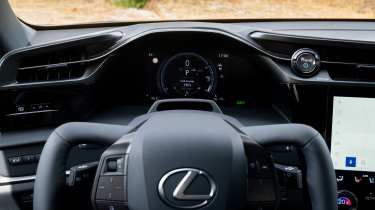
There’s good space up front, and the high centre console divides the cockpit into two distinct areas, while the central screen is angled towards the driver for ease of use. The layout is similar to many other Lexus models, so you get clear labelling and satin silver trim, while the air vents are positioned high on the dashboard. The rotary controls for these are part of the touchscreen, so it looks like they are set on the screen with the temperature numbers in the centre.
All trim levels now come with natty infra-red heaters behind the lower portion of the dash in front of the driver and front passenger’s knees, a bit like the sort of heaters up might find in the outside seating area at your local pub. It’s a low-energy consumption alternative to cranking up the heating on a cold day, and it feels like putting a blanket over your legs.
Materials and build quality
The materials used throughout the interior are befitting of a premium model, with lots of soft leather, grained plastics and metal switchgear on display. Takumi and F Sport trim RZ models include a material called Ultrasuede on the door cards that’s 30 per cent plant based, and features graphics that are applied to the surface with a laser.
One novelty that can also be found on the Lexus NX and Lexus LBX SUVs is the e-Latch electronic door release. Rather than having pull handles, the RZ has a button release on the back of the handle that opens the doors from the outside, while a similar push-button arrangement is fitted inside.
From on board, simply grab the interior handle, press the button with your thumb and push the door open at the same time. It takes a bit of getting used to, but soon becomes second nature – it also has safety benefits, because the system uses sensors to detect if you’re opening the door into approaching traffic.
Infotainment, sat-nav and stereo
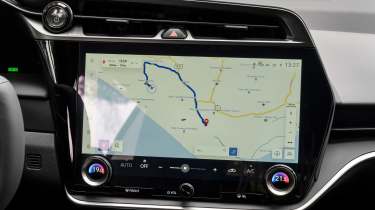
A large 14-inch display controls most of the functions in the Lexus via the Lexus Link Pro software. However, the screen is integrated with a pair of touch-sensitive climate controls beneath – the rotary temperature dials are easy to use when on the move. Still, the buttons on the smooth display are less responsive.
The main screen is easy to navigate, with shortcuts stacked vertically to the right of the screen. Another button below the main screen takes you to a custom menu where you can add frequently used functions and quickly access the driver-assistance tech. If you want to utilise your phone instead of the on-board software, then there’s both Android Auto and wireless Apple CarPlay smartphone connectivity (as well as wireless charging) are provided as standard.
However, you may still want to use the on-board sat-nav system because it includes dedicated route planning with charging stops based on the cars current state of charge. It’s also now possible to precondition the battery of the RZ (either automatically or manually via a setting in the infotainment system) ahead of rapid charging stops to help speed up charging times.
“The distinctive Sonic Copper metallic paint is a surprisingly affordable option that costs only £250, and is worth paying for just to have something that stands out in a monochrome new-car market.” – Dean Gibson, Senior test editor
Boot space, comfort & practicality
| Pros |
|
| Cons |
|
The Lexus RZ looks like a coupé-SUV from the outside, but clever EV packaging means that interior space isn’t compromised. The five-door body gives good access, with a powered tailgate fitted as standard on all variants.
Dimensions and size
The Lexus RZ looks like a coupé-SUV from the outside, but clever EV packaging means that interior space isn’t compromised. The five-door body gives good access, with a powered tailgate fitted as standard on all variants.
One glaring problem is that rear visibility could be better, especially because there’s no rear windscreen wiper to clean the screen. There are, of course, reversing cameras (Premium Plus trim and above introduce a 360-deg system) and parking sensors, which do help when reversing, but they’re no substitute for being able to look through a clear section of the rear window.
| Dimensions | |
| Length | 4,805mm |
| Width |
1,895mm 2,157mm (inc mirrors) |
| Height | 1,635mm |
| Number of seats | Five |
| Boot space | 522-1,451 litres |
Dimensions and size
The sporty profile of the Lexus RZ means it has a longer, lower appearance than some models, such as the upright Volvo EX40. It measures 4,805mm long and has a wheelbase measuring 2,850mm, which leaves short overhangs front and rear. The roofline is 1,635mm tall and blends into a steeply raked tailgate, so while it looks sporty, it’s set quite high. At 1,895mm wide, there shouldn’t be any issues with guiding the RZ through width restrictions, plus there is a full suite of parking sensors and cameras on offer to help.
Driving position, seats & space in the front
The centre console that divides the cockpit isn’t too high, so you don’t feel hemmed in by it, and there’s a wide range of wheel and seat adjustment, meaning it’s easy to get comfortable at the wheel. All models come with electrically adjustable front seats, but you’ll need to upgrade to Premium Plus trim or above to get driver’s side memory settings.
The central armrest bin has a clever lid that can be opened from the front or rear, and there is a large void beneath it for storing items. Ahead of that are a pair of cup-holders with rubber grips, plus there’s a wireless charging pad under the main touchscreen.
There’s additional hidden storage beneath the centre console that’s accessed via slots on either side. These are covered by fabric flaps that you lift, but the opening is narrow, so only slim items such as phones, wallets or glasses will be able to fit. This is a useful space to use, because there’s no glovebox.
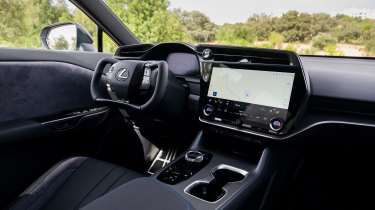
Seats & space in the back
A flat floor boosts cabin space in the back, while the seat is wide, so fitting three across it is simple enough. Legroom is good, but foot space is limited under the front seats. Two ISOFIX points are provided on the outer positions.
You might expect the RZ’s coupé-like profile to compromise headroom, but it’s actually fine – especially with Premium trim models and above that feature a panoramic roof with electrochromatic glass that eliminates the need for a retractable sunshade. This means headroom is fine.
Storage is poor in the back, with only small bottle-shaped door bins and no other pockets, but there are USB-C connections and a three-pin plug socket on the back of the central armrest for connecting devices.
Boot space
There’s a slightly high load lip on the RZ, but the floor is level with it, so loading heavier items is simple enough. The RZ has a false boot floor, though, and it lifts to reveal a deep well below that can take charging cables and other items, while lashing eyes and cargo hooks are set in the sides of the boot.
The back seats fold in a 60/40 split to leave a completely flat load area, and a maximum capacity of 1,451 litres is decent. The tonneau cover has been altered, going from the flimsy and cheap feeling bit of fabric in earlier RZ models to a more substantial design that incorporates a layer of felt in a bid to further reduce interior noise.
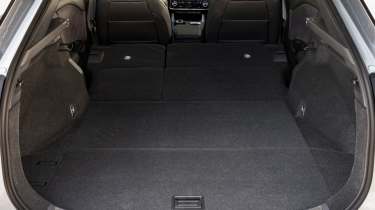
Towing
The low 750kg maximum braked towing limit of the RZ 350e means that any EV driver wishing to tow a decent-sized caravan will need to consider the pricier four-wheel drive 500e and 550e models with their greater 1,500kg capacities.
If you need something with a bit more capacity, try the Hyundai Ioniq 5 with its 1,600kg maximum braking capacity, or the Kia EV6 with up to 1,800kg of capacity.
‘I found it annoying that there aren’t any quick-release buttons to drop the rear seats from the boot. Instead, you have to run around and reach through the rear passenger doors to fold down the seats, which isn’t great when loading longer items.’ – Darren Wilson, Creative director
Reliability & safety
| Pros |
|
| Cons |
|
With the might of Toyota behind it, and a certain weight of expectation around the Japanese giant’s first dedicated electric platform, you can be sure that the Lexus RZ has been developed to be as reliable and trouble-free as possible.
If you do need to visit a Lexus dealer, you can expect some top class customer service, according to owners who have fed back to the Driver Power ownership survey. The brand finished in 3rd out of 31 manufacturers in our 2025 survey, with Lexus drivers praising value for money, infotainment ease of use, the interior, build quality, and reliability of their cars. They were less pleased with ride and handling, but since these areas have been improved with the revised RZ, the Lexus brand might yet return to the top spot next year.
Every version of RZ has lots of standard safety tech, including adaptive cruise control, lane-keep assistance, front and rear cross-traffic alert (it warns you of vehicles that’ll cross your path when reversing out on to a road), and traffic-sign recognition. Like the Subaru Soltera and Toyota bZ4X, the RZ has a driver monitor system to ensure you’re paying attention to the road. If it thinks you are falling asleep or your attention wanders, it’ll ping up a warning.
Our creative director, Darren Wilson, ran an RZ and was a fan of most of the safety systems, especially the safe exit system that will pick up cyclists approaching when you’re parallel parked on a road, and prevent you opening the door on them as they pass by. He was less pleased with the rear auto brake that in tight carparks would slam the brakes on if it thought you were going to hit something, and then take ages to let you move the car again.
| Key standard safety features |
|
| Euro NCAP safety ratings |
|
Buying and owning
Our best buy: Lexus RZ 500e Premium
Even though the revised 350e comes with a little more power, we still think the mid-range 500e is the pick of the range, and feels a much better fit for the RZ and its premium aspirations. We’re more than happy with the level of specification the entry-level Premium has, which gets all the safety technology you could want along with plenty of gadgets to keep you occupied.
Electric cars have fewer moving parts to maintain, so logic dictates that service costs should be cheaper when compared with combustion-engined models. That formula can be applied to the Lexus RZ, and the company’s fixed-price service plan costs just over £20 a month, which is around £15 a month less than a similar plan for the NX petrol hybrid SUV. However, that still means you need to budget around £700 for three years of maintenance costs when some rivals offer free servicing.
The standard Lexus warranty is three years or 60,000 miles, whichever comes first, which is similar to the sort of cover offered by the company’s premium rivals. There’s roadside assistance for the same period, too.
However, where Lexus pulls out an advantage is with its extended warranty. If you book a service at a Lexus franchise, then the company will cover your car for an additional 12 months or 10,000 miles, up to a maximum of 10 years or 100,000 miles, whichever comes first. Even better, if a regular service is missed or work is done on the car outside of the network, that won’t affect its eligibility; it’s just the time and mileage limits that apply.
The RZ’s battery warranty of eight years/100,000 miles can be extended to ten years or 600,000 miles, which is unmatched in the EV world.
Lexus RZ alternatives
There are plenty of premium compact SUVs that rival the Lexus RZ. The lower starting price places it in competition with the Audi Q4 e-tron, BMW iX1, BMW iX2, Mercedes EQA, Genesis GV60 and Volvo EX40, while the Tesla Model Y is a big-selling alternative. You could save money by choosing the Toyota bZ4X, Subaru Solterra, Volkswagen ID.4, or Volkswagen ID.5, but none of these have the premium appeal of the Lexus. At the higher end of the price range, the RZ rivals the likes of the Audi Q6 e-tron and Porsche Macan Electric, although it’s not as spacious as any of these models.
Deals on the Lexus RZ and alternatives
Lexus RZ pictures
Lexus RZ 450e Takumi long-term test
Our creative director, Darren Wilson, ran a pre-facelift Lexus RZ 450e Takumi as part of our long-term test fleet. Although the price of this range-topper was rather steep at £74,000, Darren felt that the RZ’s quality definitely reflects the price.
This all-electric luxury SUV performed well in wintery conditions, with the real-world battery range decreasing by only 19 miles, down from the 205 miles achieved in fairer and warmer weather. It’s important to note, though, that this was still 66 miles below the RZ’s WLTP combined range. You can read more about Darren’s experience with the RZ here…
Frequently Asked Questions
As with other Lexus models, the RZ has a three-year/60,000-mile warranty as standard, but this can be extended by 12 months every time the car is serviced at a Lexus dealer for a maximum of 10 years or 100,000 miles of cover.
